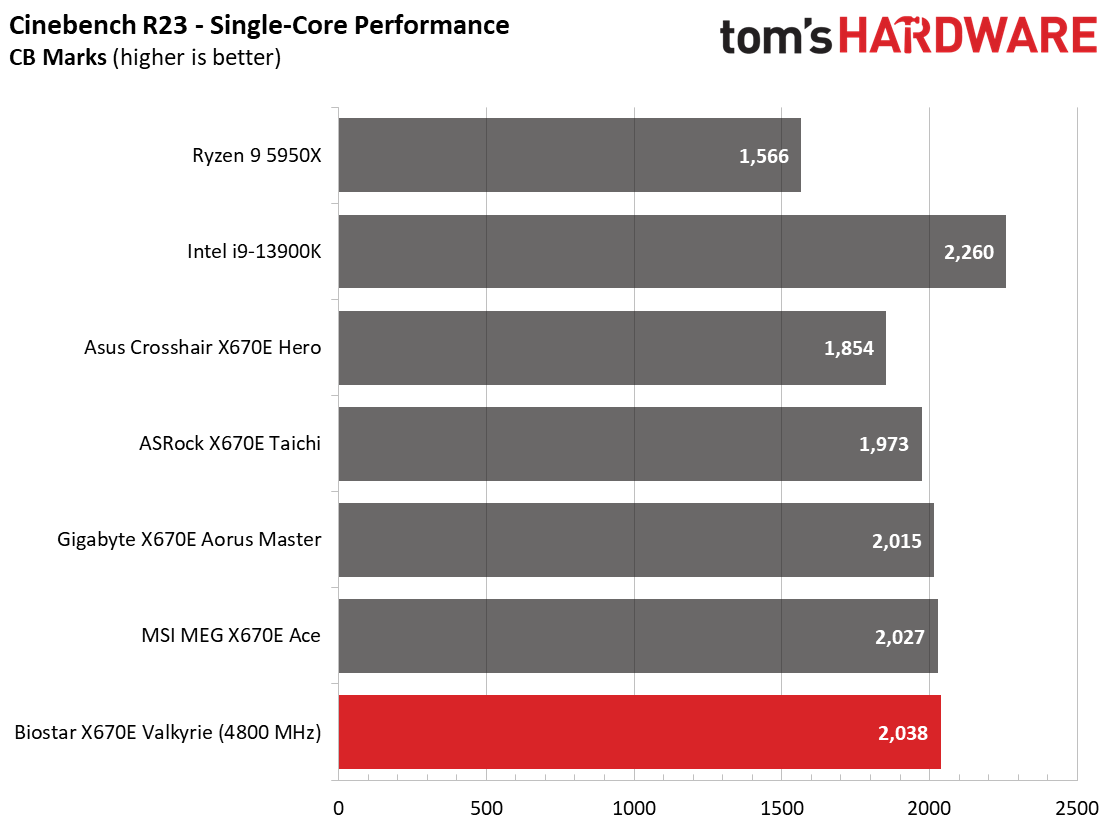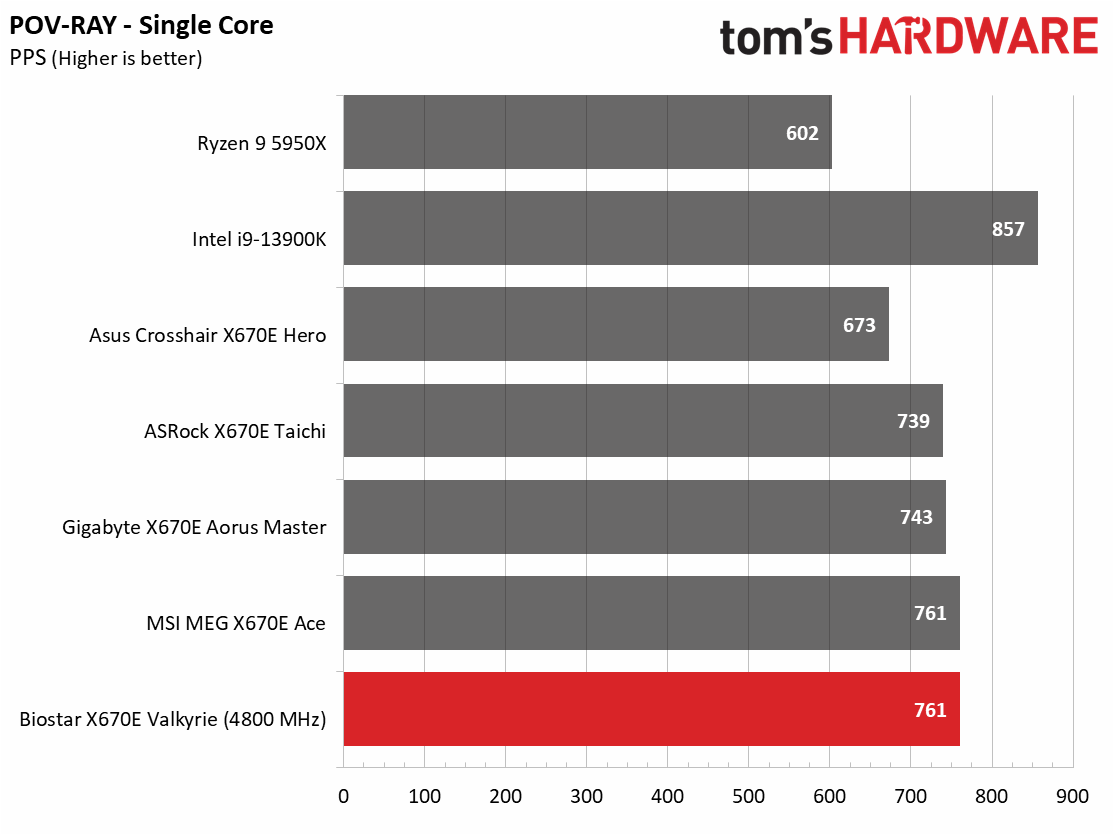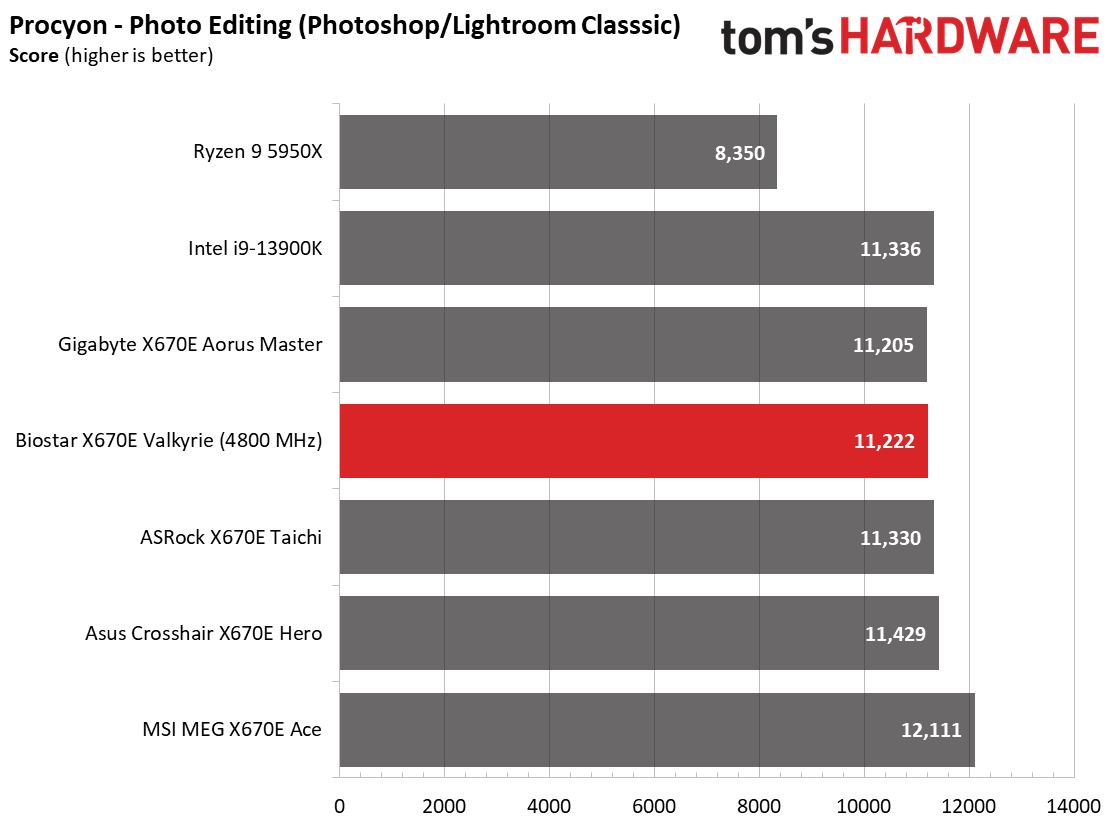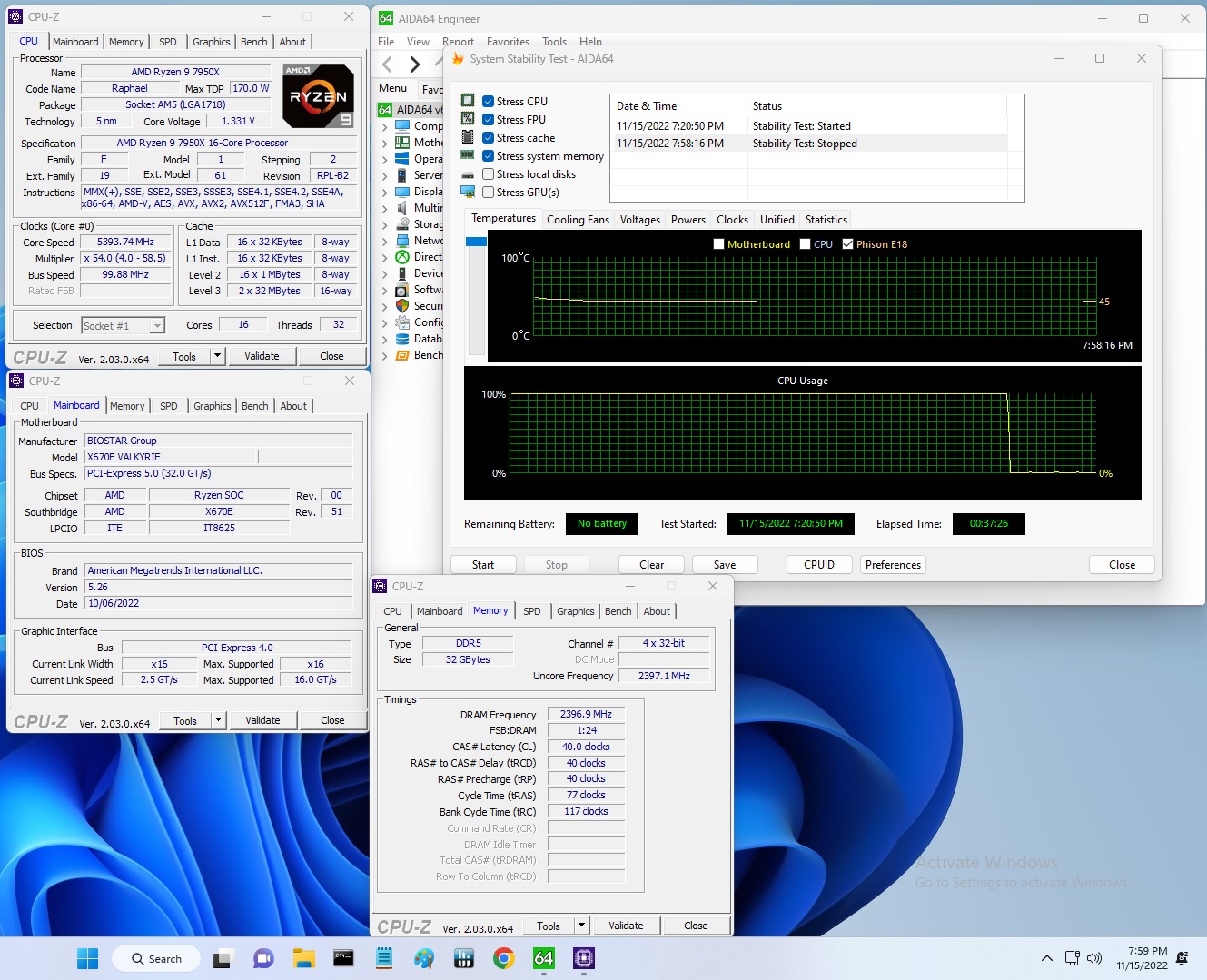Why you can trust Tom's Hardware
Our standard benchmarks and power tests are performed using the CPU’s stock frequencies (including any default boost/turbo), with all power-saving features enabled. We set optimized defaults in the BIOS and the memory by enabling the XMP profile. For this baseline testing, the Windows power scheme is set to Balanced (default) so the PC idles appropriately.
Synthetic Benchmarks
Synthetics provide a great way to determine how a board runs, as identical settings should produce similar performance results. Turbo boost wattage and advanced memory timings are places where motherboard makers can still optimize for either stability or performance, though, and those settings can impact some testing.


















Results for the X670E Valkyrie in our synthetic tests floated around the average, with some results above and others below. Surprisingly, the lower DD5-4800 speeds didn’t appear to hinder performance in most of these benchmarks.
Timed Applications




When looking at our timed applications, the LAME and Corona results were good, with above-average and average results, respectively. Handbrake results were slightly slower than the average, matching the Crosshair X670E Hero. There’s nothing abnormal about the timed benchmarks.
3D Games and 3DMark




Starting with the launch of Zen 4, we’ve updated one of our games, F1 21, to the latest version, F1 22. We're keeping Far Cry 6. We run the games at 1920 x 1080 resolution using the Ultra preset (details listed above). As the resolution goes up, the CPU tends to have less impact. The goal with these settings is to determine if there are differences in performance at the most commonly used (and CPU/system bound) resolution with settings most people use or strive for (Ultra). We expect the difference between boards in these tests to be minor, with most differences falling within the margin of error. We’ve also added a minimum FPS value, as this affects your gameplay and immersion experience.
In F1 2022, the X670E Valkyrie averaged 107 frames per second with 95 frame-per-second minimums. This result places it squarely in the middle so far. Far Cry 6 was the best average result to date, with the Valkyrie recording 141 frames per second result, or over 10% higher than the next board.
Power Consumption / VRM Temperatures
Power consumption on the X670E Valkyrie was middle of the pack. It averaged 88 Watts at idle and peaked at 289W during a stress-test load. Nothing to be concerned with here.
Get Tom's Hardware's best news and in-depth reviews, straight to your inbox.
We used AIDA64’s System Stability Test with Stress CPU, FPU, Cache and Memory enabled for power testing, using the peak power consumption value. The wattage reading is from the wall via a Kill-A-Watt meter to capture the entire PC (minus the monitor). The only variable that changes is the motherboard; all other parts remain the same.




VRM temperatures on the Valkyrie were also well within specification. At stock, VRM temperatures, according to our sensors (the board doesn’t have an internal VRM sensor, according to Hwinfo) were well within the operating parameters of the SPS MOSFETs at stock and while overclocked. There’s nothing to be concerned with regarding the power delivery or its cooling, as you’ll be limited by your CPU temperatures before the VRMs get in the way.
Overclocking
Over the last few CPU generations, overclocking headroom has been shrinking (at least on the AMD side) while the out-of-box potential has increased. For overclockers, this means there’s less fun to have. For the average consumer, it means you’re getting the most out of the processor without manual tweaking. Our goal in this section is to increase the load on the VRMs and see if they can handle the additional stress. Overclocking AMD CPUs can be done in several ways (all-core or adjust PBO values). But for simplicity’s sake, we just went with an all-core overclock of 5.4 GHz with 1.30V to increase the power output.
Since our approach is to add power through all cores, we simply raised the CPU multiplier to 54x through the BIOS, manually set the voltage to 1.30V, and adjusted LLC to minimize vdroop. There are only three LLC settings in the BIOS, so we set it to Level 1 (highest) and our 1.30V set in the BIOS turned into 1.29V in Windows, effectively eliminating vdroop. The overclock ran our stress test the first time without further tweaking. So although there aren’t many options compared to other BIOS’ what’s there did the job.
We really struggled with our memory kits on this board while testing. Although we could reach Windows and run some benchmarks at the EXPO/XMP rated speeds (5600/6000) the stress test wouldn’t pass, nor would some of the benchmarks in our test suite.
Note: After this was written, Biostar provided us with an updated BIOS that supports our GSKill DDR5-5600 kit. But that doesn’t mean the issue has been resolved with the many other kits on the market.
Bottom Line
Biostar’s X670E Valkyrie is a bit of a conundrum. On the one hand, it’s got the hardware and specifications to hang with the competition on AMD’s latest and greatest platform. Sure, it’s missing 40 Gbps USB ports and integrated Wi-Fi, but if you need those features, you can add them. Performance differences were nominal across most tests and the board kept up with the others. While the Valkyrie may not have the high-end look as other boards in its class, it blends in well with most themes and sports a nice RGB glow to illuminate the inside of your chassis.
Where it falls short, currently, is memory compatibility. Neither of our kits did not work using the XMP/EXPO profiles, and we were forced to run JEDEC specs (4800 MHz) on these kits for stability. Biostar’s memory support list is short compared to the others, and none of the popular GSkill kits were on the list when we wrote this article. If you plan to use this board past the 5200 MHz maximum on the platform, you need to stick with a kit on the company’s currently short memory support list. Hopefully, Biostar gets past these teething issues sooner than later, as no other boards we’ve tested so far have tripped up on our memory kits. While overclocking was successful, if you’re trying to push things to the limit, you’ll find fewer overclocking options here compared to other boards.
Biostar sais the MSRP is “roughly $400,” though we can only find the Valkyrie for sale online for $499.99. That price point has some quality competition, including the Asus ROG Strix X670-E Gaming WIFI ($499.99), Gigabyte X670E Aorus Master ($499.99), ASRock X670E Taichi ($469.99), and the MSI MPG X670E Carbon WIFI ($479.99). Within this peer group, you’ll find similar hardware (robust power delivery, dual PCIe 5.0 M.2 sockets), though most boards use the latest-gen audio codec and all include Wi-Fi where the Valkyrie doesn’t. If integrated 40 bps ports are important, only the Taichi has them natively. Looks are subjective, and while Valkyrie won’t detract from your build, the others give off a more premium vibe. If you can find the board at its MSRP, it becomes a better value.
Currently available for $499.99, the X670E Valkyrie just isn’t on the same level as other boards at this price point. From included Wi-Fi, better BIOSes with more functionality and better memory compatibility out of the box, there are few reasons to choose this board over others in its current state and price. Once the memory support is sorted out and the price gets closer to its MSRP, it will be more appealing, so long as you don’t need integrated Wi-Fi and 40 Gbps ports. However, at $499 and even $400, there are more mature options available.
MORE: Best Motherboards
MORE: How To Choose A Motherboard
MORE: All Motherboard Content

Joe Shields is a staff writer at Tom’s Hardware. He reviews motherboards and PC components.

